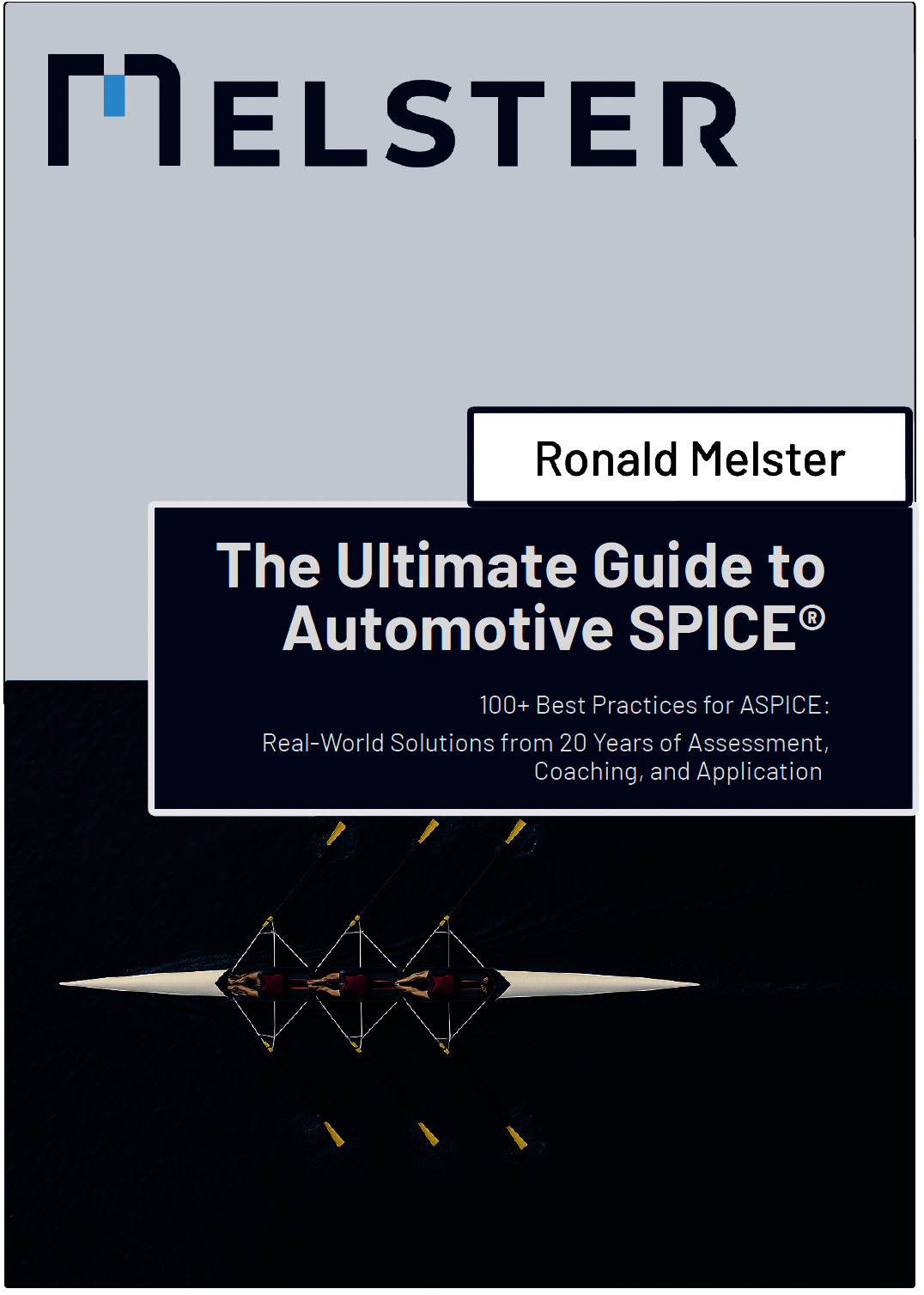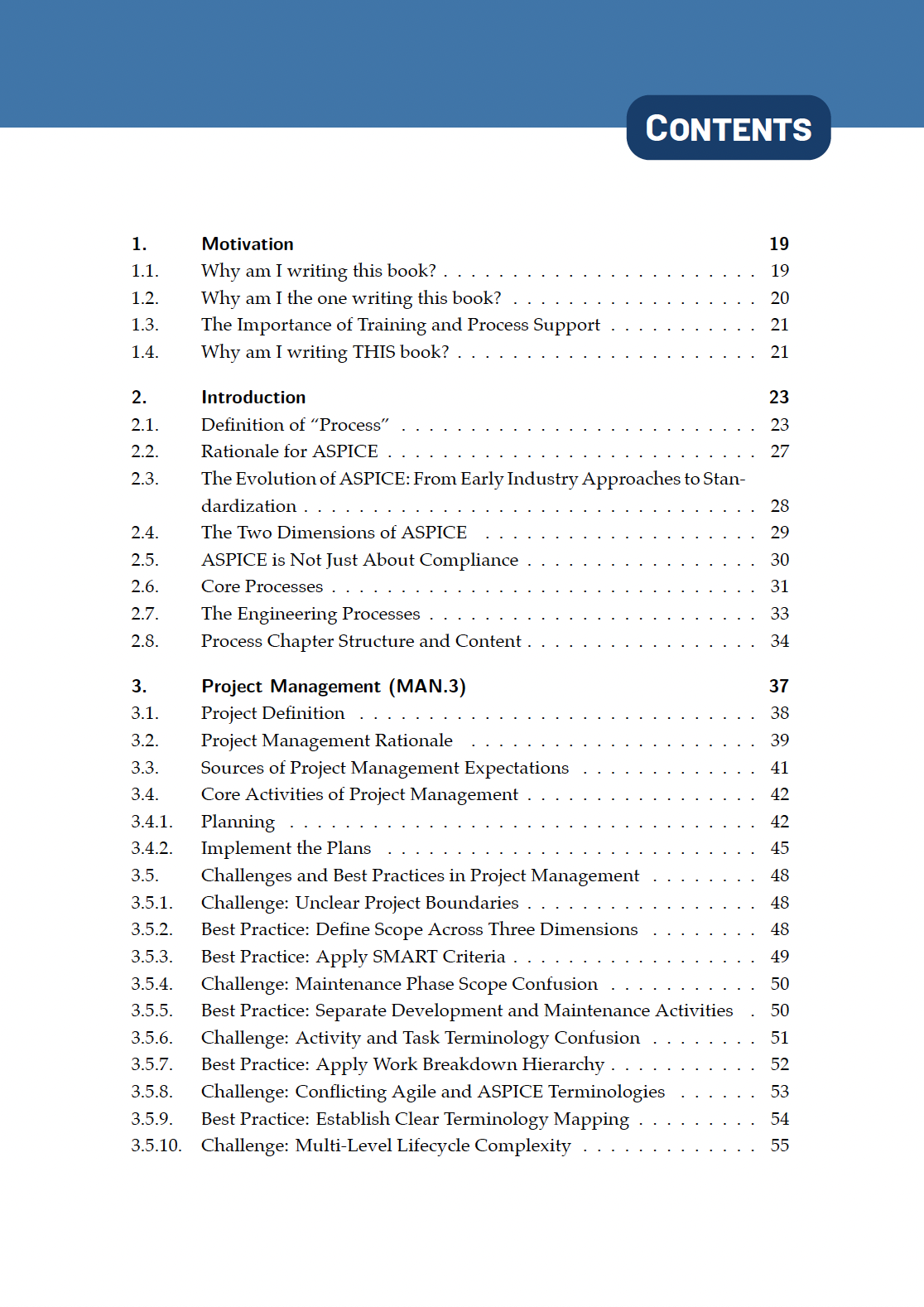The Ultimate Guide to Automotive SPICE®
Practical solutions, proven concepts, and tried-and-tested recommendations for development professionals in the automotive industry.
The practical ASPICE bible for quality professionals & project teams
„The Ultimate Guide to Automotive SPICE®“ offers practical, directly applicable solutions for typical challenges in implementing ASPICE in engineering projects. The book is based on decades of assessment and coaching experience and is aimed at teams who want to do more than just “pass” ASPICE, but rather translate it into measurable process improvement and project success.
What makes this book special?
- 100+ Best Practices: Compact action guides derived directly from real improvement and assessment projects.
- Focus on challenges: A proven solution strategy is presented for each practical problem.
- Illustrative stories: The theoretical requirements of the standard are linked to examples, approaches, and short stories from everyday project work—not just a mere recitation of the standard!
- English version: The only current ASPICE book in English – ideal for international teams.
- Modern & compact: Not a dry list of processes and base practices, but a consolidated, structured guide
- From the long-standing experienced assessor: Ronald Melster (BOSCH, Porsche, Audi, and much more) has 20 years of experience in process improvement in the automotive industry.
This book shows you how to implement the ASPICE Cybersecurity Extension in your projects. It is based on version 2.0 and explains how to integrate the six cybersecurity processes into existing ASPICE processes.
Book details
- Author: Ronald Melster
- Print edition: approx. 496 pages (A5 format)
- eBook/Kindle: approx. 380-520 pages (depending on device)
- ISBN: 978-3-9827736-1-2 (print)
- Publication date: September 2025
- Publisher: Melster Consulting GmbH
Olga Polishchuk
Scrum Master at Luxoft
This book is a practical and insightful guide for applying ASPICE in real-world projects. I found the best practices especially useful for SUP.8, where the example on backup responsibilities helped clarify a key issue in my organization. The book is easy to follow, filled with real-life scenarios, and supported by valuable resources like masterclasses and interview guides. A great companion for any software professional working with ASPICE.
Olena Lizina
Senior Project Manager / ASPICE Provisional Assessor at Luxoft DXC
This book is a real treasure for anyone implementing ASPICE. I only wish I had it sooner! When I was starting out - it would have saved me so much time and uncertainty. Even today, I keep coming back to it whenever I need to refresh my memory or gain clarity. What makes it truly special is that it's written for the people who build and improve processes, not just for assessors.
Wojciech Dziembala
Project Systems Lead / Product Owner / Automotive / SAFe Leadership / Customer Relations / Systems Engineer / Project Management / ASPICE at Aptiv
The Most Practical and Inspiring ASPICE Guide Available
This book is an absolute game-changer for anyone working with Automotive SPICE®. I've read other resources on ASPICE, but none of them manage to combine practical depth, expert authority, and clarity the way this one does. It really exceeded my expectations. What makes it stand out is how the author begins with the Core processes, which are mandatory for Level 2 and in practice the real foundation for starting and structuring any project. Too often these are treated as secondary, but here they are placed exactly where they belong - at the entry point to successful engineering.
I also really like the way processes are grouped and compared across domains. For example, showing SYS.2 alongside SWE.1 and HWE.1, or SYS.3 with SWE.2, HWE.2, and SWE.3, makes the V-model come alive not only for systems but also for software and hardware. This structured comparison helps to understand ASPICE as a coherent engineering model instead of isolated checklists.
On a personal note, if I had read this book earlier, before creating my own ASPICE Basics course, it would have made my work even better. I did use the Melster Academy as a source, but this book goes far beyond. It is a true collection of best practices (not just base practices), guiding the reader on how to build processes that make achieving Level 2 or higher much easier and more natural.
For me, this is the book I wish I had years ago. It combines clarity, structure, and practical insight in a way no other ASPICE resource does. Reading it feels like having an expert assessor sit beside you, guiding you through each step.
Katarzyna Czerwiec
Quality manager / IATF 16949 Auditor Ex-Aptiv
Ronald Melster’s The Ultimate Guide to Automotive SPICE® is a clear, practical, and experience-driven handbook for anyone working with ASPICE. Unlike many texts that focus on compliance, this book emphasizes real process improvement and engineering success. Drawing on decades of industry experience, the author explains not just what ASPICE requires, but why it matters and how to apply it effectively. Each chapter balances concepts with actionable best practices, making it useful for engineers, project managers, and quality professionals alike. What stands out is the author’s pragmatic approach: ASPICE is presented not as bureaucracy, but as a framework that helps teams work faster, with fewer mistakes, and greater predictability. In short, this is an excellent resource for organizations seeking both compliance and genuine improvement in their engineering practices. Highly recommended.
Available formats
| Format | Price | Region | Order |
|---|---|---|---|
| PDF (Community Edition) | EUR 42 | Direct download with watermark | BUY NOW |
| Kindle eBook | ~$40 (may vary by region) | Number of pages varies depending on device | Buy on Amazon |
| Print edition (Amazon) | ~EUR 69 | 496 pages, A5 format | Buy on Amazon |
| Print edition | EUR 45 with voucher EUR 55 regular price | 457 pages, A5 format | ORDER |
Who is this book for?
This book is aimed at:
- Engineers and developers
- Project managers
- Quality assurance professionals
- Managers who want to build a sustainable engineering culture
What will you learn?
The book presents over 100 best practices for ASPICE based on 20 years of assessment and coaching experience. It shows how ASPICE is applied in real-world projects.
- Practical application of the most important ASPICE processes
- Best practices from assessment and coaching experience
- Solutions for recurring challenges
1. Motivation (page 13)
- Why am I writing this book?
2. Introduction (page 17)
- Cybersecurity relevance criteria
- ASPICE Cybersecurity Extension v2.0
3. Overview of the standard (page 23)
- Cybersecurity engineering processes
- MAN.7 Cybersecurity risk management
- SEC.1 Cybersecurity requirements elicitation
- SEC.2 Cybersecurity implementation
- SEC.3 Risk treatment verification
- SEC.4 Risk treatment validation
- ACQ.2 Supplier request and selection
- ACQ.4 Supplier monitoring
4. Cybersecurity risk analysis (page 41)
- Item Definition as a Prerequisite
- Asset Identification
- Impact Assessment
- Threat Scenario Identification
- Attack Feasibility Assessment
- Risk Determination
- Cybersecurity Goal Derivation
5. Integration into Core ASPICE Processes (page 53)
- Integration with MAN.3 Project Management
- Interface to SUP.1 Quality Assurance
- Interface to SUP.8 Configuration Management
- Interface to SUP.9 Problem Resolution Management
6. Cybersecurity in Development Processes (page 65)
- Requirements Engineering (SEC.1 and SWE.1/HWE.1)
- Implementation and Architecture (SEC.2 and SWE.2/SWE.3)
- Verification (SEC.3 and SWE.6/SYS.5)
- Validation (SEC.4)
- Security-Specific Interface Management
- Test Data, Secrets, and Environment Control
7. Conclusion (page 83)
- Key Findings

